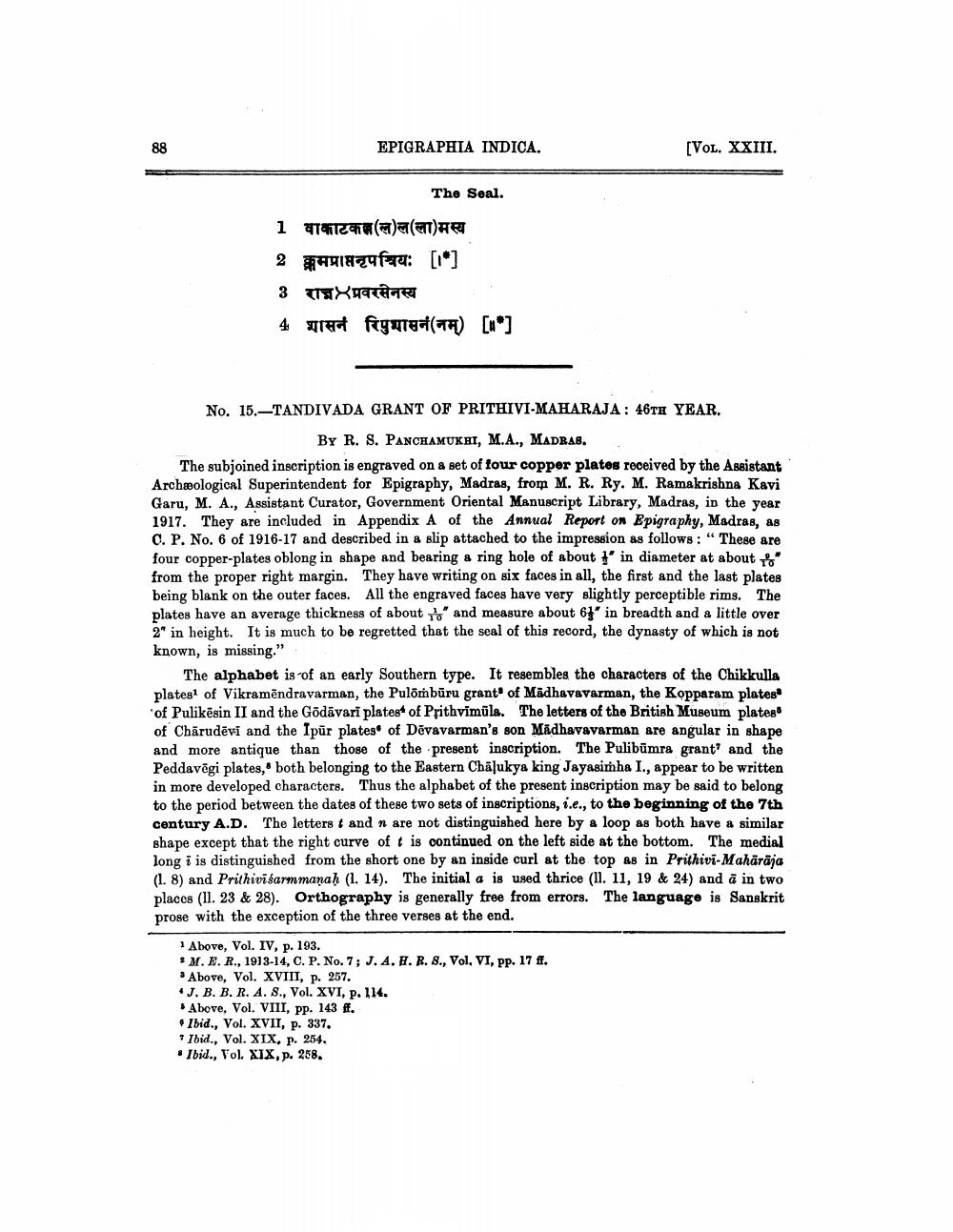________________
EPIGRAPHIA INDICA.
[Vol. XXIII.
The Seal.
1 412 (a) (The 2 491aftu: [l*] 3 Xacher 4 art figurat(TH) [0*]
No. 15.-TANDIVADA GRANT OF PRITHIVI-MAHARAJA : 46TH YEAR.
BY R. S. PANCHAMUKHI, M.A., MADRAS. , The subjoined inscription is engraved on a set of four copper platos received by the Assistant Archeological Superintendent for Epigraphy, Madras, from M. R. Ry. M. Ramakrishna Kavi Garu, M. A., Assistant Curator, Government Oriental Manuscript Library, Madras, in the year 1917. They are included in Appendix A of the Annual Report on Epigraphy, Madras, as O. P. No. 6 of 1916-17 and described in a slip attached to the impression as follows: “ These are four copper-plates oblong in shape and bearing a ring hole of about 1' in diameter at about " from the proper right margin. They have writing on six faces in all, the first and the last plates being blank on the outer faces. All the engraved faces have very slightly perceptible rims. The plates have an average thickness of about to" and measure about 61' in breadth and a little over 2" in height. It is much to be regretted that the seal of this record, the dynasty of which is not known, is missing."
The alphabet is of an early Southern type. It resembles the characters of the Chikkulla platest of Vikramēndravarman, the Pulombūru grant of Madhavavarman, the Kopparam plates 'of Pulikēsin II and the Gödāvari platest of Prithvimūla. The letters of the British Museum plates of Chārudēvi and the Ipūr plates of Dēvavarman's son Madhavavarman are angular in shape and more antique than those of the present inscription. The Pulibūmra grant' and the Peddavēgi plates, both belonging to the Eastern Chāļukya king Jayasimha I., appear to be written in more developed characters. Thus the alphabet of the present inscription may be said to belong to the period between the dates of these two sets of inscriptions, i.e., to the beginning of the 7th century A.D. The letters t and n are not distinguished here by a loop as both have a similar shape except that the right curve of t is continued on the left side at the bottom. The medial long iis distinguished from the short one by an inside curl at the top as in Prithivi-Mahārāja (1. 8) and Prithivisarmmanah (1. 14). The initial a is used thrice (11. 11, 19 & 24) and a in two places (11. 23 & 28). Orthography is generally free from errors. The language is Sanskrit prose with the exception of the three verses at the end.
1 Above, Vol. IV, p. 193. * M. E. R., 1913-14, C. P. No. 7; J.A. H. R. 8., Vol. VI, pp. 17 ff. * Above, Vol. XVIII, p. 257. • J. B. B. R. A. 8., Vol. XVI, p. 114.
Above, Vol. VIII, pp. 143 f. Ibid., Vol. XVII, p. 337. * Ibid., Vol. XIX, p. 254. • Ibid., vol. XIX, p. 258.




